Analysis of Eco-Environmental Geological Problems and Their Driving Forces in the Henan Section of the Yellow River Basin, China
Abstract
1. Introduction
2. Materials and Methods
2.1. Study Area
2.2. Data Sources
3. Research Methods
3.1. Soil Erosion Analysis
3.2. Functional Analysis of Soil and Water Conservation
3.3. Analysis of Water Conservation Function
3.4. Analysis of Biodiversity Maintenance Function
3.5. Analysis of the Susceptibility of Geological Disasters
3.6. Comprehensive Analysis of the Ecological Environment and Geological Problems
4. Results
4.1. Soil Erosion Analysis
4.2. Functional Analysis of Soil and Water Conservation
4.3. Analysis of Water Conservation Function
4.4. Analysis of Biodiversity Maintenance Function
4.5. Analysis of the Susceptibility of Geological Disasters
4.6. Ecological Environment and Geology of River Basin
4.7. Driving Force Analysis
4.7.1. Driving Force Analysis of the Sanmenxia–Zhengzhou Section
4.7.2. Analysis of Driving Force in the Zhengzhou–Puyang Section
5. Discussion
6. Conclusions
Author Contributions
Funding
Conflicts of Interest
References
- Wang, W.J.; Jiang, W.G.; Fang, Z. Assessment of Ten Year Change of Ecological Environment in the Yellow River Basin; Science Press: Beijing, China, 2017. [Google Scholar]
- Pasculli, A.; Palermi, S.; Sarra, A.; Piacentini, T.; Miccadei, E. A modelling methodology for the analysis of radon potential based on environmental geology and geographically weighted regression. Environ. Model. Softw. 2014, 54, 165–181. [Google Scholar] [CrossRef]
- Patricia, D.A.P.; De Lima, O.A.L. Contaminations at the derma of Gaia: A case study in environmental geology. Environ. Earth Sci. 2016, 75, 1429. [Google Scholar]
- Anatol’yevna, M.T.; Viktorovich, E.S. Unified Multimodal Transport Center A Tool for the Development of the Environmental Geology of Transport. Procedia Eng. 2017, 189, 138–144. [Google Scholar] [CrossRef]
- Feng, Q.Y.; Yan, J.P. Environmental Geology; China University of Mining and Technology Press: Xuzhou, China, 2011. [Google Scholar]
- Zhou, K. The mother river of the Chinese nation—The Yellow River. Gansu Water Resour. Hydropower Technol. 2015, 51, 62–63. [Google Scholar]
- Yu, F.W.; Fang, L. Issues regarding the ecological protection and high-quality development of Yellow River Basin. China Soft Sci. 2020, 6, 85–95. [Google Scholar] [CrossRef]
- Chen, Y.; Miao, Q.Q.; Zhou, Q. Spatiotemporal Differentiation and Driving Force Analysis of the High-Quality Development of Urban Agglomerations along the Yellow River Basin. Int. J. Environ. Res. Public Health 2022, 19, 2484. [Google Scholar] [CrossRef]
- Guo, D.D. Some thoughts on ecological protection and high-quality development of cities along the Yellow River. Decis. Mak. Explor. (II) 2020, 10, 7–8. [Google Scholar]
- Zhang, Y.L.; Su, H.M.; Zhang, X.Y. Temporal and spatial analysis of vegetation cover change in the Yellow River basin from 1998 to 2012. Desert China 2014, 34, 597–602. [Google Scholar]
- Wu, C.B.; Liu, Y.P. Ecological geological survey—The situation and Enlightenment of Russia. Land Resour. Inf. 2003, 15, 36–42. [Google Scholar]
- Zhang, Z.H.; Yuan, D.X. A major geoscience problem across the century in China—The development prospect of Environmental Geoscience. Sci. Technol. Manag. Land Resour. 1995, 2, 60–69. [Google Scholar]
- Chen, M.X. On Eco geological environment system and comprehensive eco environmental geological survey. Hydrogeol. Eng. Geol. 1999, 21, 3–12. [Google Scholar] [CrossRef]
- Huang, R.Q. Basic characteristics and technical support of the eco-environmental geology. Chin. Geol. 2001, 28, 20–24. [Google Scholar] [CrossRef]
- Lu, Y.R. Geological Ecological Environment and Sustainable Development; Hohai University Press: Nanjing, China, 2003. [Google Scholar]
- Su, Y.D.; Deng, X.Y. A study on eco-geological environment system and comprehensive ecological environment geology. Constr. Des. Eng. 2017, 10, 107–108. [Google Scholar]
- Peng, J.B.; Lan, X.X. A brief discussion on ecological geology and ecological geological environment system. J. Earth Sci. Environ. 2022, 44, 877–893. [Google Scholar] [CrossRef]
- Yang, X.C.; Shi, Y.; Feng, S.T.; Wang, C.M.; Chai, J.L. Main eco-environmental geological problems and countermeasures in the lower reaches of the Yellow River (Shandong section). Shandong Land Resour. 2010, 26, 15–18. [Google Scholar]
- Yang, Z.J.; Zhang, S.Q.; Li, B.M.; Wang, Y.G.; An, Y.; Shi, W.D.; Xin, Y.H. Research on the ecological and environmental geological survey and mapping techniques of the Qinghai Tibet Plateau. Geol. Northwest China 2008, 3, 112–123. [Google Scholar]
- Liu, X.M.; Guo, C.Q. Evaluation of regional eco-environmental geological quality based on SDS evaluation model—Taking the southwest of Hainan Island as an example. Hydrogeol. Eng. Geol. 2007, 3, 85–88. [Google Scholar]
- Xu, X.N.; Wang, W.J.; Huang, R.Q. GIS based eco-environmental geological quality assessment of the Anning River basin. J. Chengdu Univ. Technol. Nat. Sci. Ed. 2004, 3, 243–248. [Google Scholar]
- Liu, G.N.; Wu, Y.; Wang, S.C.; Liao, J.; Yu, S.W.; Fu, Y.P.; Du, Y.; Chen, L.Z. Major water environment problems and ecological environment geological risk assessment zoning of typical river lake wetlands in the middle reaches of the Yangtze River. Geol. South China 2022, 38, 226–239. [Google Scholar]
- Zhang, L.S.; Li, L.H.; Gong, X.J. The significant ecological environmental geological problems and countermeasure research on the lower course of the Yellow River in Henan Province. Henan Geol. 2001, 1, 71–78. [Google Scholar]
- Wang, L.L.; Zhu, X.C.; Li, M. Study on organic pollution of drinking source of Yellow River valley in Henan Province. Environ. Pollut. Control. 2004, 2, 104–106. [Google Scholar] [CrossRef]
- Cao, X.Q.; Ma, Y.; Zhao, H.Y. Ecological environmental geological problems and their prevention countermeasures in coal mining areas of Henan Province. Min. Saf. Environ. Prot. 2006, 33, 130–132. [Google Scholar] [CrossRef]
- Huang, P.; Ye, Y.Z.; Gao, H.M.; Wang, X.; Jiang, S.; Yin, W. Biodiversity investigation and assessment of YiHe-Luohe River Basin in Henan Province. J. Henan Norm. Univ. (Nat. Sci. Ed.) 2012, 40, 142–145. [Google Scholar]
- Liu, T.K.; Yuan, C.F. Thoughts on the importance evaluation of water conservation function based on GIS—A case study of the Yellow River Basin in Henan Province. Reg. Gov. 2020, 4, 118–120. [Google Scholar]
- Xu, J.Q.; Ye, J.; Zhang, L.; Liu, J.F. Water conservation of Danjiangkou reservoir in He’nan remote sensing monitoring of ecological environment in national key. Environ. Dev. 2018, 30, 147–149. [Google Scholar]
- Fan, Y.C. Achievements and practices of ecological construction of soil and water conservation in the Yellow River Basin of Henan Province. Soil Water Conserv. China 2016, 10, 24–26. [Google Scholar]
- Renard, K.G.; Foster, G.R.; Weesies, G.A.; McCool, D.K.; Yoder, D.C. Predicting Soil Erosion by Water: A Guide to Conservation Planning with the Revised Universal Soil Loss Equation (RUSLE); Agricultural Handbook; USDA: Washington, DC, USA, 1997. [Google Scholar]
- Wang, S.; Zhang, B.; Wang, S.; Xie, G.D. Dynamic changes in water conservation in the Beijing–Tianjin Sandstorm Source Control Project Area: A case study of Xilin Gol League in China. J. Clean. Prod. 2021, 293, 126054. [Google Scholar] [CrossRef]
- Wang, T.F.; Gong, Z.W. Evaluation and analysis of water conservation function of ecosystem in Shaanxi Province in China based on “Grain for Green” Projects. Environ. Sci. Pollut. Res. Int. 2022, 29, 83878–83896. [Google Scholar] [CrossRef]
- Ma, K.P. On the concept of biodiversity. Biodivers. Sci. 1993, 1, 20–22. [Google Scholar] [CrossRef]
- Guo, Q.H.; Hu, T.Y.; Jiang, Y.X.; Jin, S.; Wang, R.; Guan, H.; Yang, Q.; Li, Y.; Wu, F.; Zhai, Q.; et al. Advances in remote sensing application for biodiversity research. Biodivers. Sci. 2018, 26, 789–806. [Google Scholar] [CrossRef]
- Wang, X.D.; Zhang, C.B.; Wang, C.; Liu, G.W.; Wang, H.X. GIS-based for prediction and prevention of environmental geological disaster susceptibility: From a perspective of sustainable development. Ecotoxicol. Environ. Saf. 2021, 226, 112881. [Google Scholar] [CrossRef] [PubMed]
- Wang, N.T.; Peng, K.; Li, Q.H.; Zhao, W.X.; Li, Y.Y.; He, J. Quantitative evaluation of geological disaster liability based on RS and GIS analiysis: A case study of Wufeng County, Hubei Province. Earth Sci. Front. 2012, 19, 221–229. [Google Scholar]
- Yang, Y.H.; Wen, G.C.; Xie, H.B.; Wang, L. Characteristics of normalized vegetation index under typical geomorphic units in Qaidam Basin. Bull. Soil Water Conserv. 2020, 40, 133–139. [Google Scholar]
- Gilani, H.; Ahmad, A.; Younes, I.; Abbas, S. Impact assessment of land cover and land use changes on soil erosion changes (2005–2015) in Pakistan. Land Degrad. Dev. 2021, 33, 204–217. [Google Scholar] [CrossRef]
- Li, N.; Wang, X.J.; Lu, G.; Li, J.Y. Temporal and spatial changes of soil erosion in Xibaiyanggou watershed on the northern slope of Tianshan mountains from 200-2017. J. Arid. Land Resour. Environ. 2021, 35, 73–79. [Google Scholar] [CrossRef]
- Zou, X.Y.; Zhou, W.; Sun, W.J.; Xiao, K.B.; Hu, F.B.; Lin, Z. Research progress on influencing factors of soil erosion of engineering accumulation body in China. J. Northeast Agric. Sci. 2021, 46, 57–61. [Google Scholar]
- Liu, T.K. Study on Ecological Protection Red Line in Yellow River Basin of Henan Province. Master’s Thesis, North China University of Water Resources and Electric Power, Zhengzhou, China, 2020. [Google Scholar]
- Li, H.C.; Guan, Q.Y.; Sun, Y.F.; Wang, Q.Z.; Liang, L.S.; Ma, Y.R.; Du, Q.Q. Spatiotemporal analysis of the quantitative attribution of soil water erosion in the upper reaches of the Yellow River Basin based on the RUSLE-TLSD mode. Catena 2022, 212, 106081. [Google Scholar] [CrossRef]
- Yin, Y.H.; Wu, S.H.; Zhao, D.S.; Dai, E.F. Ecosystem water conservation changes in response to climate change in the source region of the Yellow River from 1981 to 2010. Geogr. Res. 2016, 35, 49–57. [Google Scholar] [CrossRef]
- Gao, P.; Deng, J.C.; Chai, X.K.; Mu, X.M.; Zhao, G.J.; Shao, H.B.; Sun, W.Y. Dynamic sediment discharge in the Hekou–Longmen region of Yellow River and soil and water conservation implications. Sci. Total Environ. 2017, 578, 56–66. Available online: https://pubmed.ncbi.nlm.nih.gov/27396320 (accessed on 13 October 2022). [CrossRef]
- Liu, C.L.; Zhao, X.B.; Zhang, H.T.; Peng, Z.; Li, W. The eco-environmental geological conditions and prevention measures of the Yellow River National Geopark, in Zhengzhou. Acta Geol. Sichuan 2011, 31, 442–445. [Google Scholar]
- Wang, J.F.; Xu, C.D. Geodetector: Principle and prospective. Acta Geogr. Sin. 2017, 72, 116–134. [Google Scholar] [CrossRef]
- Wang, H.M.; Liu, H.; Sang, J.; Li, X.Y.; Su, M. Spatial-temporal characteristics of vegetation cover and the correlation with climate in Hulunbeir. J. Inn. Mong. Univ. 2020, 51, 539–547. [Google Scholar] [CrossRef]
- Zhao, C.S.; Liu, J.; Xu, J.Z.; Fan, Y.C. Achievements and challenges of ecological construction of soil and water conservation in the Yellow River Basin of Henan Province. Soil Water Conserv. China 2021, 2, 20–22. [Google Scholar]
- Zhou, X.F.; Cao, G.Z.; Yu, F.; Yang, W.S.; Xu, Z.S. Risk zoning of water pollution in the Yellow River Basin. Environ. Sci. 2021, 43, 2448–2458. [Google Scholar] [CrossRef]
- Fu, S.L. Biodiversity conservation along the Yellow River should emphasize the complex spatial heterogeneity. Biodivers. Sci. 2020, 28, 445–1446. [Google Scholar] [CrossRef]
- Li, Y.Z.; Feng, Z.Z.; Li, L.; An, D.; Wang, W.J. Assessment of ecological sensitivity of terrestrial ecosystem in the Yellow River Basin based on GIS. Environ. Sci. Technol. 2021, 44, 219–225. [Google Scholar] [CrossRef]
- Zhao, X.D.; Zhao, Y.M. Current situation, protection and management of wetlands along the Yellow River in Henan. Wetl. Sci. Manag. 2016, 12, 27–29. [Google Scholar] [CrossRef]
- Tian, D.S. Evaluation on geological hazard dangerous condition in Henan Province. J. Catastrophology 2014, 29, 48–51. [Google Scholar] [CrossRef]
- Wu, J.J.; Zhao, G.Y.; Li, H.; Hu, D.T.; Zhang, L. Study on the Statistical Law of Geological Hazard Distribution in Henan Province. Mod. Min. 2009, 25, 48–51. [Google Scholar]
- Lan, H.X.; Peng, J.B.; Zhu, Y.B.; Li, L.P.; Pan, B.T.; Huang, Q.B.; Li, J.H.; Zhang, Q. Geological and surficial processes and major disaster effects in the Yellow River Basin. Sci. China Earth Sci. 2022, 52, 199–221. [Google Scholar] [CrossRef]
- Song, S.H.; Li, H.K.; Zhang, Z.W. Spatial and temporal change analysis of soil erosion in the source area of the Dongjiang River based on RUSLE model. J. Earth Environ. 2022, 13, 344–353. [Google Scholar]
- Liu, Y.S.; Feng, W.L.; Li, Y.R. Modern Agricultural Geographic Engineering and High quality Agricultural Development—Taking Loess Hilly and Gully Areas as an Example. J. Geogr. 2020, 75, 2029–2046. [Google Scholar]
- Liu, L.; Wei, J.; Ma, Y.; Luo, Q.; Wang, Z. Temporal and spatial changes for ecological environment of Yellow River in Henan province. Environ. Sci. Manag. 2021, 46, 169–173. [Google Scholar]
- Ye, H.M.; Hua, W.P.; Wu, X.Y.; Hu, J.P.; Su, L.M.; Yang, H.; Zhao, Z.L.; Wu, C.Z. Effects of land use on soil erosion and nutrient loss in small watershed in red soil hilly area. Environ. Chem. 2022, 41, 4154–4164. [Google Scholar]
- Guo, L.Y.; Sun, Y.Y.; Wang, T. Remote sensing monitoring and evaluation of ecological environment quality in soil and water conservation functional areas of the Loess Plateau. J. Xi’an Univ. Technol. 2022, 1–11. [Google Scholar]
- Li, Y.C.; Liu, C.X.; Zhao, C.Y.; Huang, J.H. Spatial and temporal pattern characteristics of water and soil loss in Chongqing section of the Three Gorges Reservoir Area. J. Geogr. 2008, 5, 475–486. [Google Scholar]
- Shen, Z.X.; Zhang, Q.; Wu, W.H.; Song, C.Q. Spatial pattern and driving factors of geological hazard prone areas on the Qinghai Tibet Plateau and Hengduan Mountains. J. Geogr. 2022, 77, 1211–1224. [Google Scholar]
- Zhang, J.L.; Chen, K.; Zhang, C.; Guo, P.C. The change characteristics of eco-environment in the Yellow River Basin based on entropy weights. China Environ. Sci. 2021, 41, 3767–3774. [Google Scholar] [CrossRef]
- Ning, Z.R.; Yang, X.M.; Chen, Y.J. Ecological protection and restoration of mountains-rivers-forests-farmlands-lakes-grasslands in Nantaihang area, Henan Province: Integrated landscape management. Acta Ecol. Sin. 2019, 39, 8886–8895. [Google Scholar] [CrossRef]
- Huang, S.W.; Li, J.; Zhang, X.J.; Deng, L.; Zhang, J. Analysis of spatial and temporal changes in soil erosion in Henan Province over the last ten years. J. Agric. Resour. Environ. 2021, 38, 232–240. [Google Scholar] [CrossRef]
- Lan, H.X.; Zhu, Y.B.; Li, L.P.; Pan, B.T.; Hu, Z.B.; Peng, J.B. Research on multi process interaction of geology, geomorphology and climate in the Yellow River Basin and its gestation mechanisms on major disasters. Bull. Natl. Nat. Sci. Found. China 2021, 35, 510–519. [Google Scholar] [CrossRef]

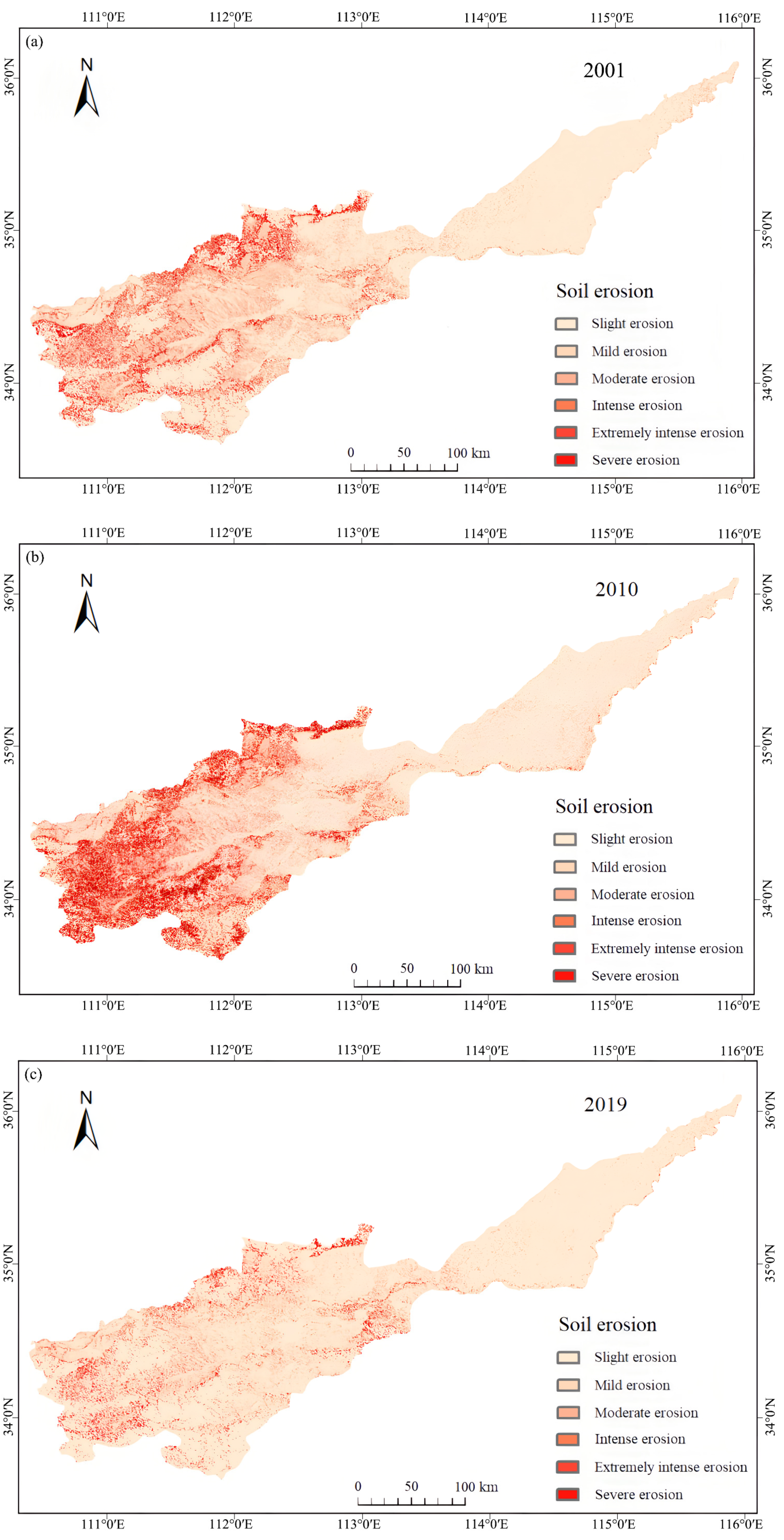

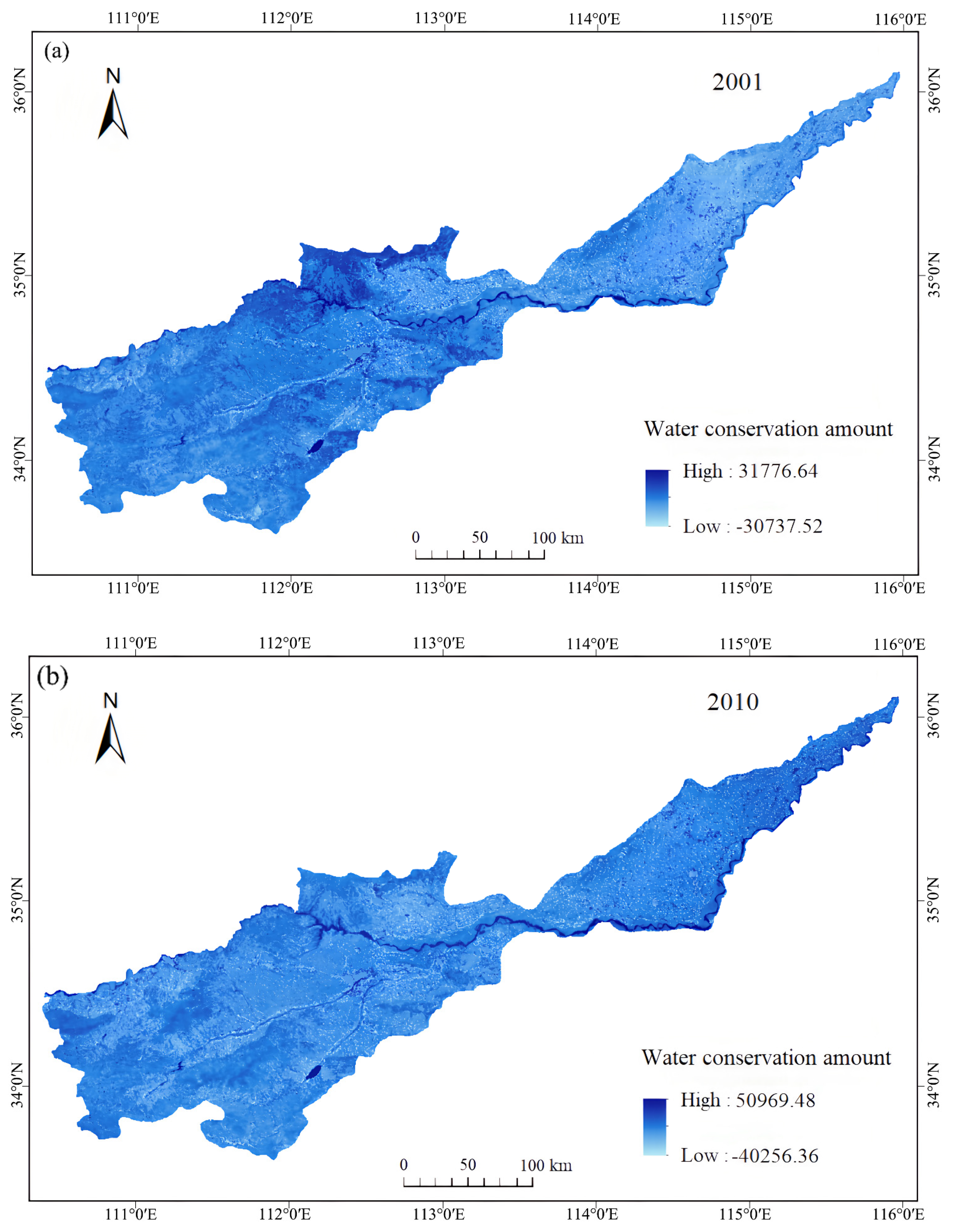
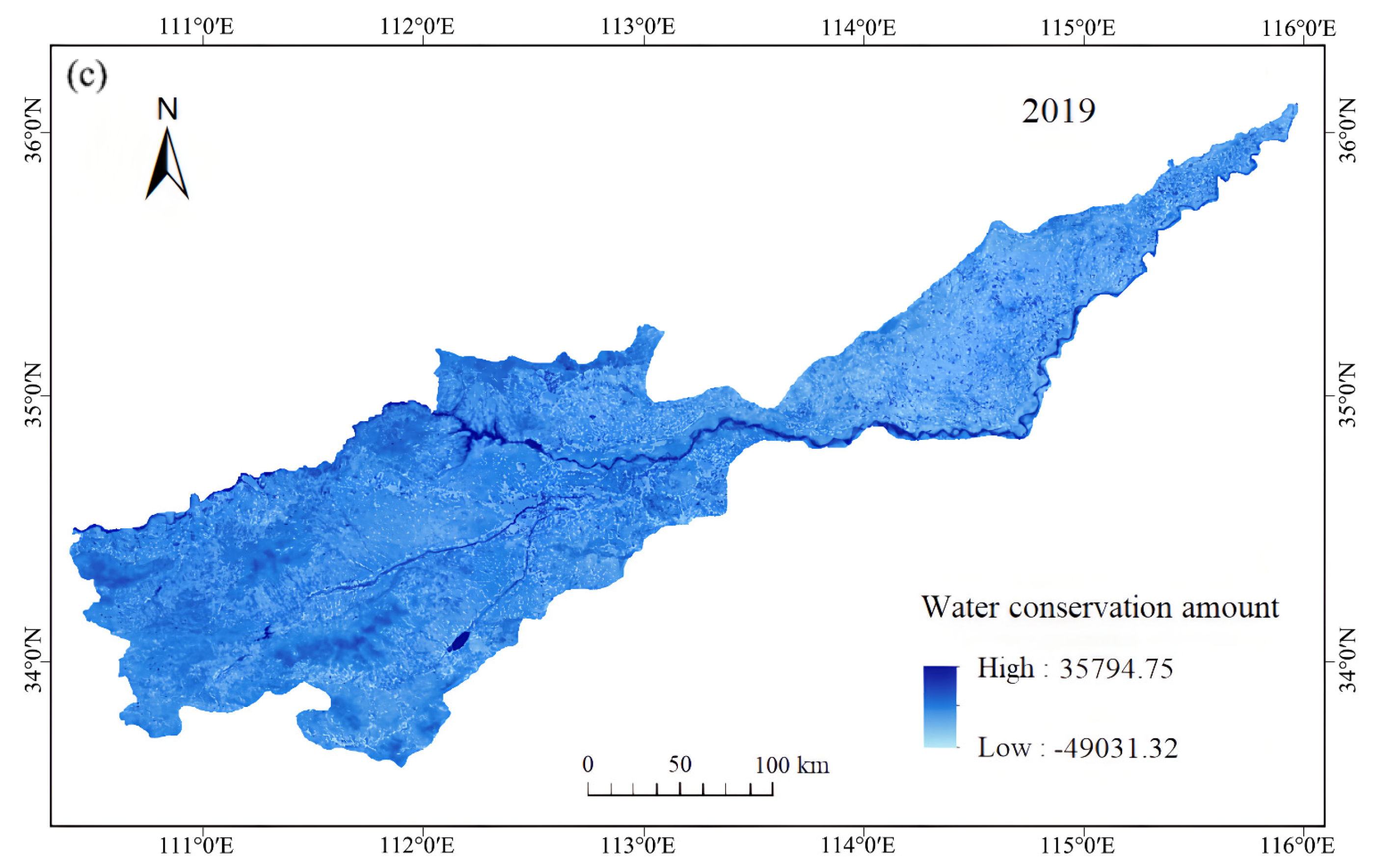
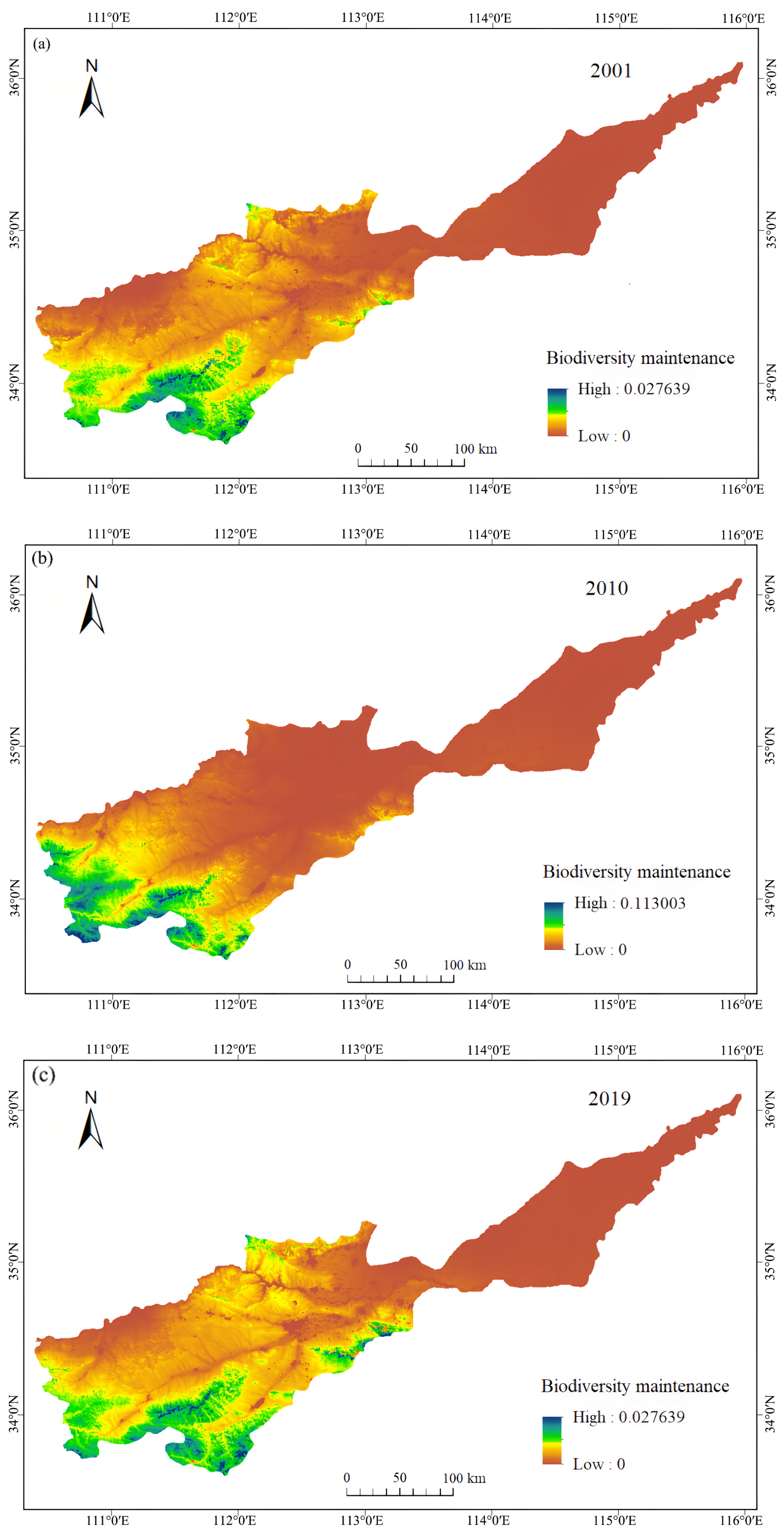
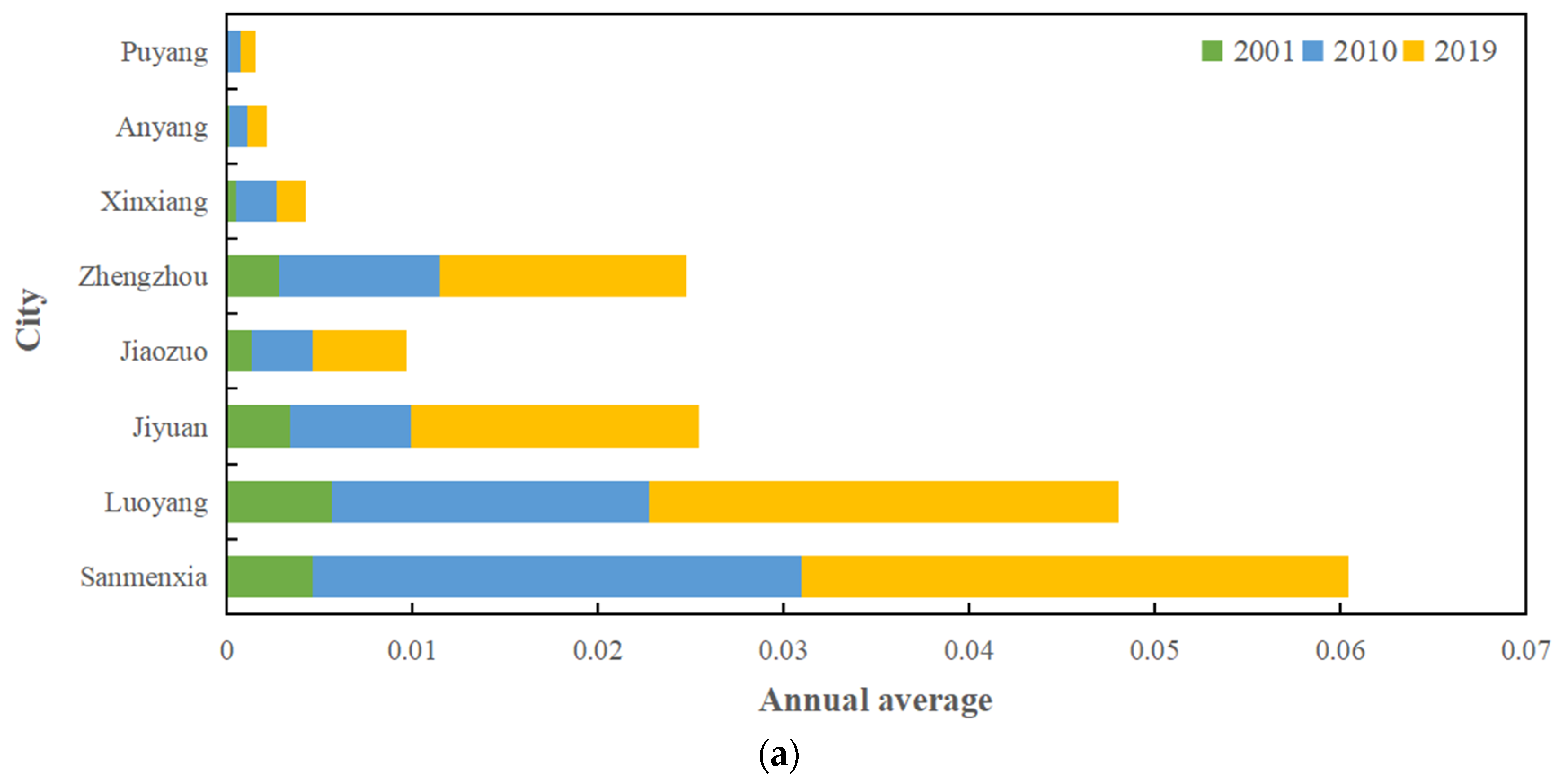
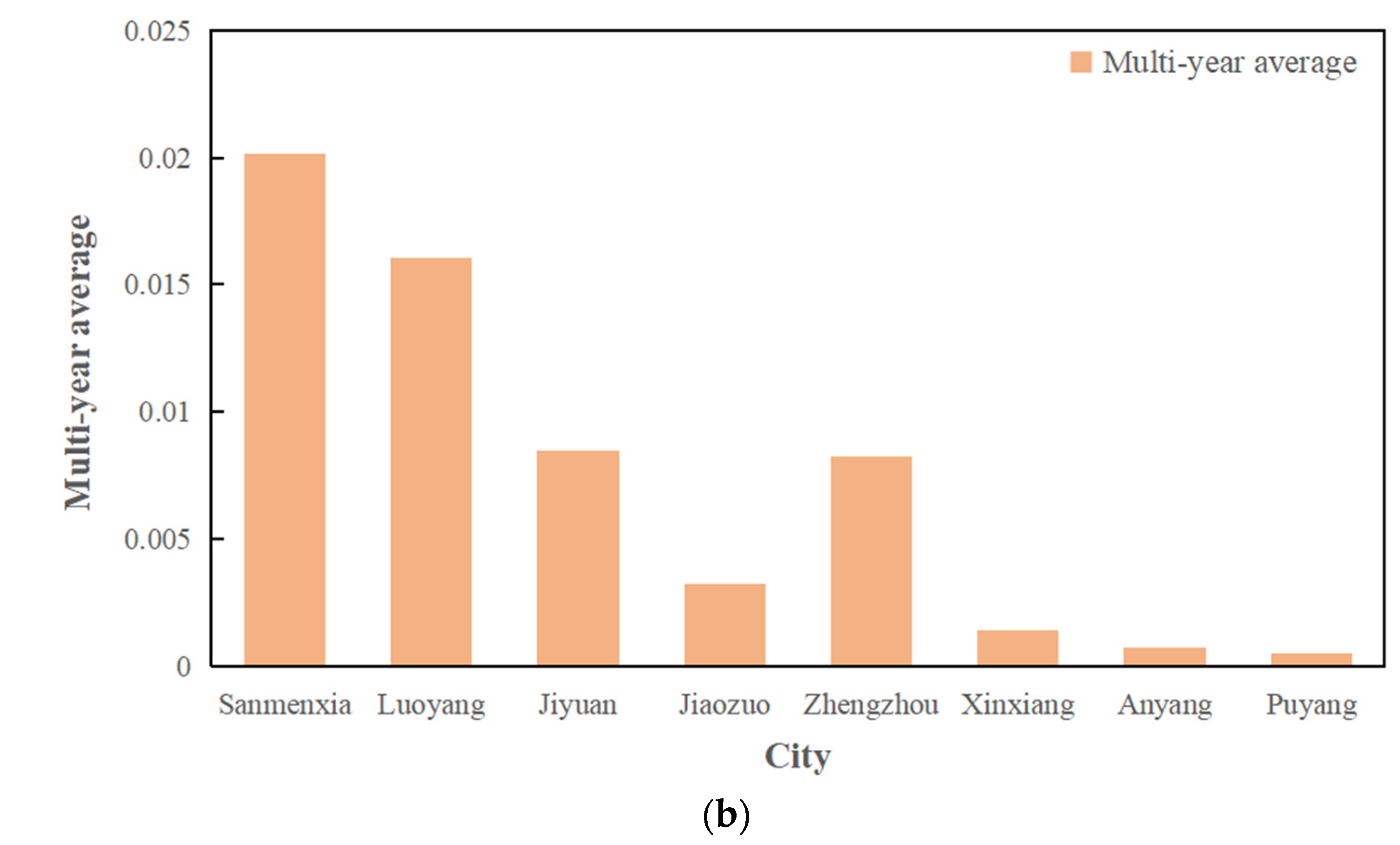

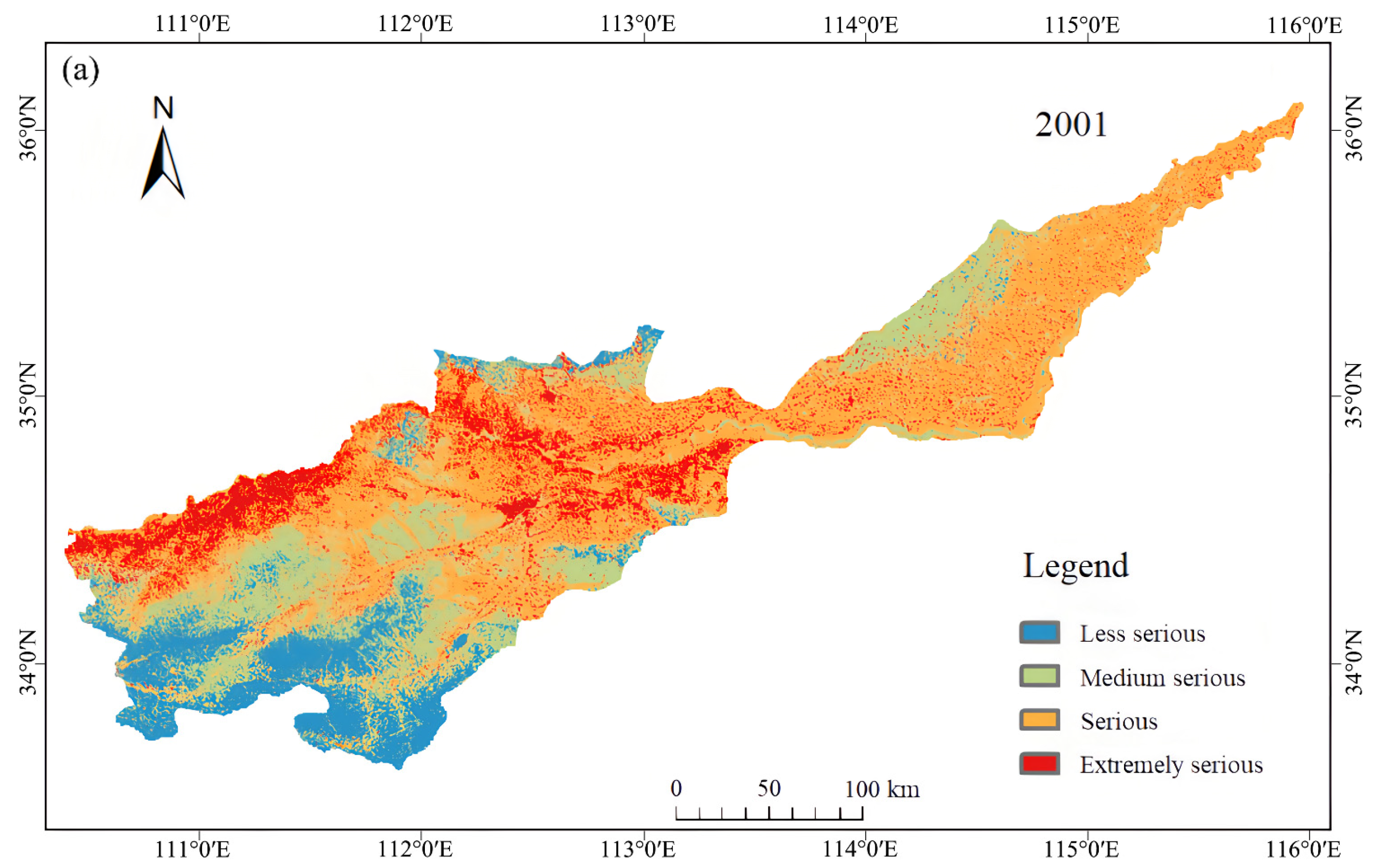
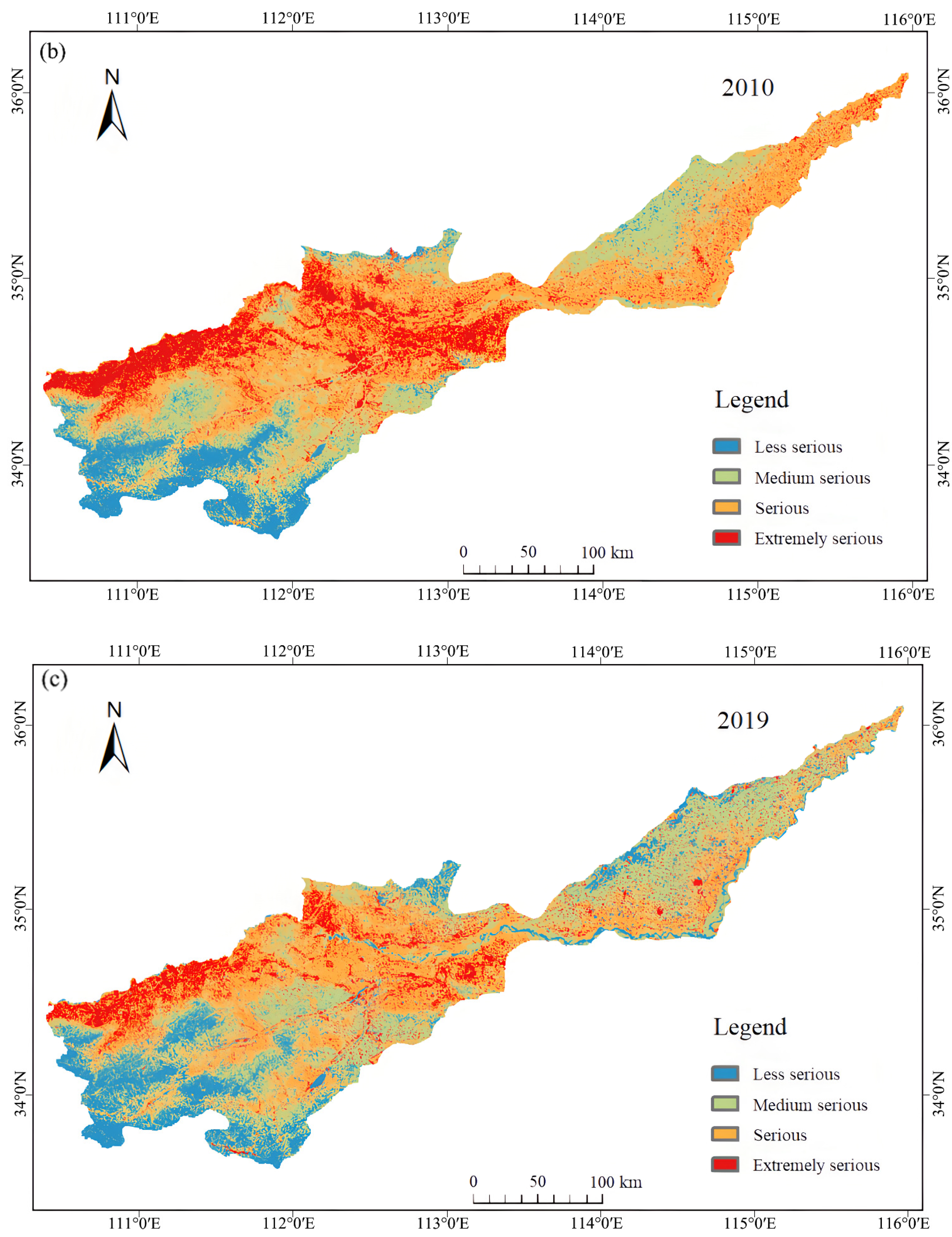
| Study Area | Sensor | Year | Row Number |
|---|---|---|---|
| The south section of the Yellow River Basin | Landsat TM | 2001 | 123/35 123/36 124/36 125/36 135/37 126/37 |
| Landsat TM | 2010 | ||
| Landsat OLI | 2019 |
| Soil Erosion Levels | Soil Erosion Modulus (t·km−2·a−1) | Average Loss Thickness (mm·a−1) |
|---|---|---|
| Slight erosion | <200 | <0.15 |
| Mild erosion | 200–2500 | 0.15–1.9 |
| Moderate erosion | 2500–5000 | 1.9–3.7 |
| Intense erosion | 5000–8000 | 3.7–5.9 |
| Extremely intense erosion | 8000–15,000 | 5.9–11.1 |
| Severe erosion | >15,000 | >11.1 |
| Factor | Weight of Factor (2001) | Weight of Factor (2010) | Weight of Factor (2019) |
|---|---|---|---|
| Distance from the Yellow River main stream | 0.1862 | 0.1788 | 0.1838 |
| Vegetation coverage | 0.1576 | 0.1730 | 0.1748 |
| Rainfall | 0.1295 | 0.1421 | 0.1333 |
| Slope | 0.2297 | 0.2198 | 0.2290 |
| Soil type | 0.1386 | 0.1336 | 0.1342 |
| Distance from the mining area | 0.1585 | 0.1527 | 0.1549 |
| Detection Indicators | Explanatory Power (q) | ||
|---|---|---|---|
| 2001 | 2010 | 2019 | |
| Elevation | 0.359 | 0.209 | 0.333 |
| Slope | 0.174 | 0.062 | 0.145 |
| Rainfall | 0.212 | 0.152 | 0.219 |
| Temperature | 0.021 | 0.037 | 0.089 |
| Evapotranspiration | 0.145 | 0.096 | 0.187 |
| Vegetation coverage | 0.281 | 0.171 | 0.303 |
| Land-use type | 0.183 | 0.152 | 0.218 |
| NPP | 0.169 | 0.096 | 0.209 |
| Mining activities | 0.148 | 0.038 | 0.183 |
| Detection Indicators | 2001 | 2010 | 2019 | |||
|---|---|---|---|---|---|---|
| Correlation | Two-Tailed | Correlation | Two-Tailed | Correlation | Two-Tailed | |
| Elevation | 0.279 | 0.561 | 0.010 | 0.646 | 0.030 | 0.110 |
| Slope | 0.018 | 0.373 | 0.037 | 0.076 | 0.030 | 0.170 |
| Rainfall | −0.372 ** | 0 | −0.304 ** | 0 | −0.420 ** | 0 |
| Temperature | 0.289 ** | 0 | 0.105 ** | 0 | 0.150 ** | 0 |
| Evapotranspiration | 0.088 | 0.412 | 0.017 | 0.422 | 0.030 | 0.170 |
| Vegetation coverage | −0.367 ** | 0 | −0.288 ** | 0 | −0.280 ** | 0 |
| Land-use type | 0.316 ** | 0 | 0.294 ** | 0 | 0.150 ** | 0 |
| NPP | −0.053 | 0.352 | −0.016 | 0.437 | −0.030 | 0.110 |
Disclaimer/Publisher’s Note: The statements, opinions and data contained in all publications are solely those of the individual author(s) and contributor(s) and not of MDPI and/or the editor(s). MDPI and/or the editor(s) disclaim responsibility for any injury to people or property resulting from any ideas, methods, instructions or products referred to in the content. |
© 2023 by the authors. Licensee MDPI, Basel, Switzerland. This article is an open access article distributed under the terms and conditions of the Creative Commons Attribution (CC BY) license (https://creativecommons.org/licenses/by/4.0/).
Share and Cite
Wen, G.; Wu, B.; Wang, L.; Wang, X.; Xie, H. Analysis of Eco-Environmental Geological Problems and Their Driving Forces in the Henan Section of the Yellow River Basin, China. Sustainability 2023, 15, 6818. https://doi.org/10.3390/su15086818
Wen G, Wu B, Wang L, Wang X, Xie H. Analysis of Eco-Environmental Geological Problems and Their Driving Forces in the Henan Section of the Yellow River Basin, China. Sustainability. 2023; 15(8):6818. https://doi.org/10.3390/su15086818
Chicago/Turabian StyleWen, Guangchao, Bingjie Wu, Lin Wang, Xiaohe Wang, and Hongbo Xie. 2023. "Analysis of Eco-Environmental Geological Problems and Their Driving Forces in the Henan Section of the Yellow River Basin, China" Sustainability 15, no. 8: 6818. https://doi.org/10.3390/su15086818
APA StyleWen, G., Wu, B., Wang, L., Wang, X., & Xie, H. (2023). Analysis of Eco-Environmental Geological Problems and Their Driving Forces in the Henan Section of the Yellow River Basin, China. Sustainability, 15(8), 6818. https://doi.org/10.3390/su15086818






